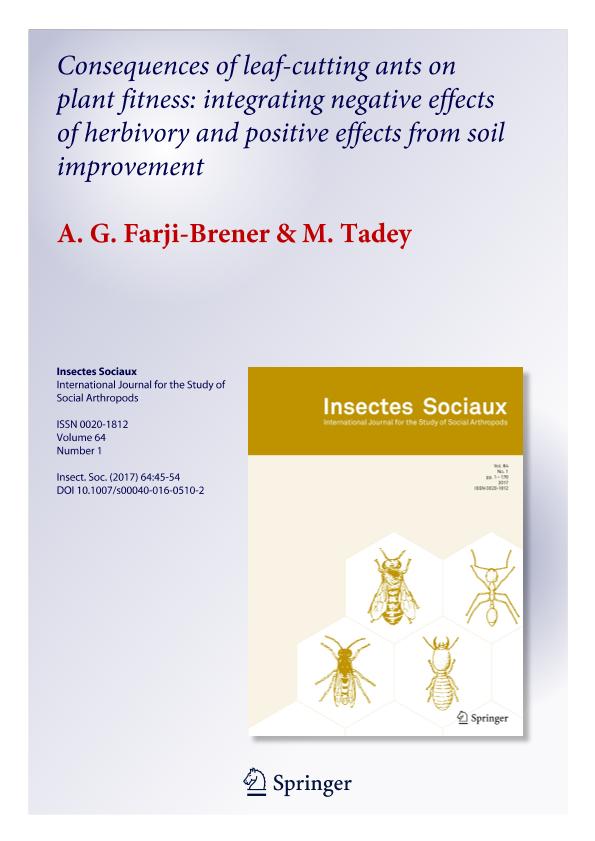Mostrar el registro sencillo del ítem
dc.contributor.author
Farji Brener, Alejandro Gustavo

dc.contributor.author
Tadey, Mariana

dc.date.available
2019-02-06T17:30:13Z
dc.date.issued
2017-02
dc.identifier.citation
Farji Brener, Alejandro Gustavo; Tadey, Mariana; Consequences of leaf-cutting ants on plant fitness: integrating negative effects of herbivory and positive effects from soil improvement; Birkhauser Verlag Ag; Insectes Sociaux; 64; 1; 2-2017; 45-54
dc.identifier.issn
0020-1812
dc.identifier.uri
http://hdl.handle.net/11336/69524
dc.description.abstract
A better understanding of plant–herbivore relationships should integrate negative and positive effects of consumers on plant fitness. We studied the effect of a major insect herbivore (leaf-cutting ants, LCA) on plant fitness in several species of Monte Desert, assessing both the direct negative effect of ant defoliation and the indirect positive role of ants as soil improvers. To estimate the negative and positive effects on plants, we sampled 7000 plant fragments carried by the ants and analyzed the nutrient contents of refuse dumps in 15 ant nests. We estimated plant fitness measuring ~10,000 flowers and ~3600 fruits of 122 individuals from 7 of the most common plant species within the ant foraging area. First, we compared the fitness between plants growing on the nutrient-rich refuse dumps and co-specifics on adjacent non-nest soils. Second, using hierarchical confirmatory path analysis model, we analyzed how herbivory and nutrient content of refuse dumps affected plant fitness. We found that the fitness of plants growing on refuse dumps (a) was similar than those growing on adjacent non-nest soils, and (b) was unaffected by ant harvesting or by increments in nutrient content in a consistent way. In this dry habitat, the effect of LCA on plant fitness was complex and species-dependent. To explain this pattern, we discuss the role of plant compensation to foliar damage, the limited plant response to soil nutrients due to water stress and the potential high abundance plant consumers on ant refuse dumps. Our results illustrate the complexity of herbivore-plant interactions emphasizing the need of measuring direct and indirect effects of herbivory in field conditions to validate greenhouse experiments.
dc.format
application/pdf
dc.language.iso
eng
dc.publisher
Birkhauser Verlag Ag

dc.rights
info:eu-repo/semantics/openAccess
dc.rights.uri
https://creativecommons.org/licenses/by-nc-sa/2.5/ar/
dc.subject
Acromyrmex Lobicornis
dc.subject
Ant Foraging
dc.subject
Indirect Effects
dc.subject
Monte Desert
dc.subject
Nest Effects
dc.subject
Patagonia
dc.subject
Plant Fitness
dc.subject
Structural Equation Models
dc.subject.classification
Otras Ciencias Biológicas

dc.subject.classification
Ciencias Biológicas

dc.subject.classification
CIENCIAS NATURALES Y EXACTAS

dc.title
Consequences of leaf-cutting ants on plant fitness: integrating negative effects of herbivory and positive effects from soil improvement
dc.type
info:eu-repo/semantics/article
dc.type
info:ar-repo/semantics/artículo
dc.type
info:eu-repo/semantics/publishedVersion
dc.date.updated
2019-01-23T19:03:58Z
dc.journal.volume
64
dc.journal.number
1
dc.journal.pagination
45-54
dc.journal.pais
Suiza

dc.journal.ciudad
Basilea
dc.description.fil
Fil: Farji Brener, Alejandro Gustavo. Consejo Nacional de Investigaciones Científicas y Técnicas. Centro Científico Tecnológico Conicet - Patagonia Norte. Instituto de Investigaciones en Biodiversidad y Medioambiente. Universidad Nacional del Comahue. Centro Regional Universidad Bariloche. Instituto de Investigaciones en Biodiversidad y Medioambiente; Argentina
dc.description.fil
Fil: Tadey, Mariana. Consejo Nacional de Investigaciones Científicas y Técnicas. Centro Científico Tecnológico Conicet - Patagonia Norte. Instituto de Investigaciones en Biodiversidad y Medioambiente. Universidad Nacional del Comahue. Centro Regional Universidad Bariloche. Instituto de Investigaciones en Biodiversidad y Medioambiente; Argentina
dc.journal.title
Insectes Sociaux

dc.relation.alternativeid
info:eu-repo/semantics/altIdentifier/doi/https://dx.doi.org/10.1007/s00040-016-0510-2
dc.relation.alternativeid
info:eu-repo/semantics/altIdentifier/url/https://link.springer.com/article/10.1007/s00040-016-0510-2
Archivos asociados
